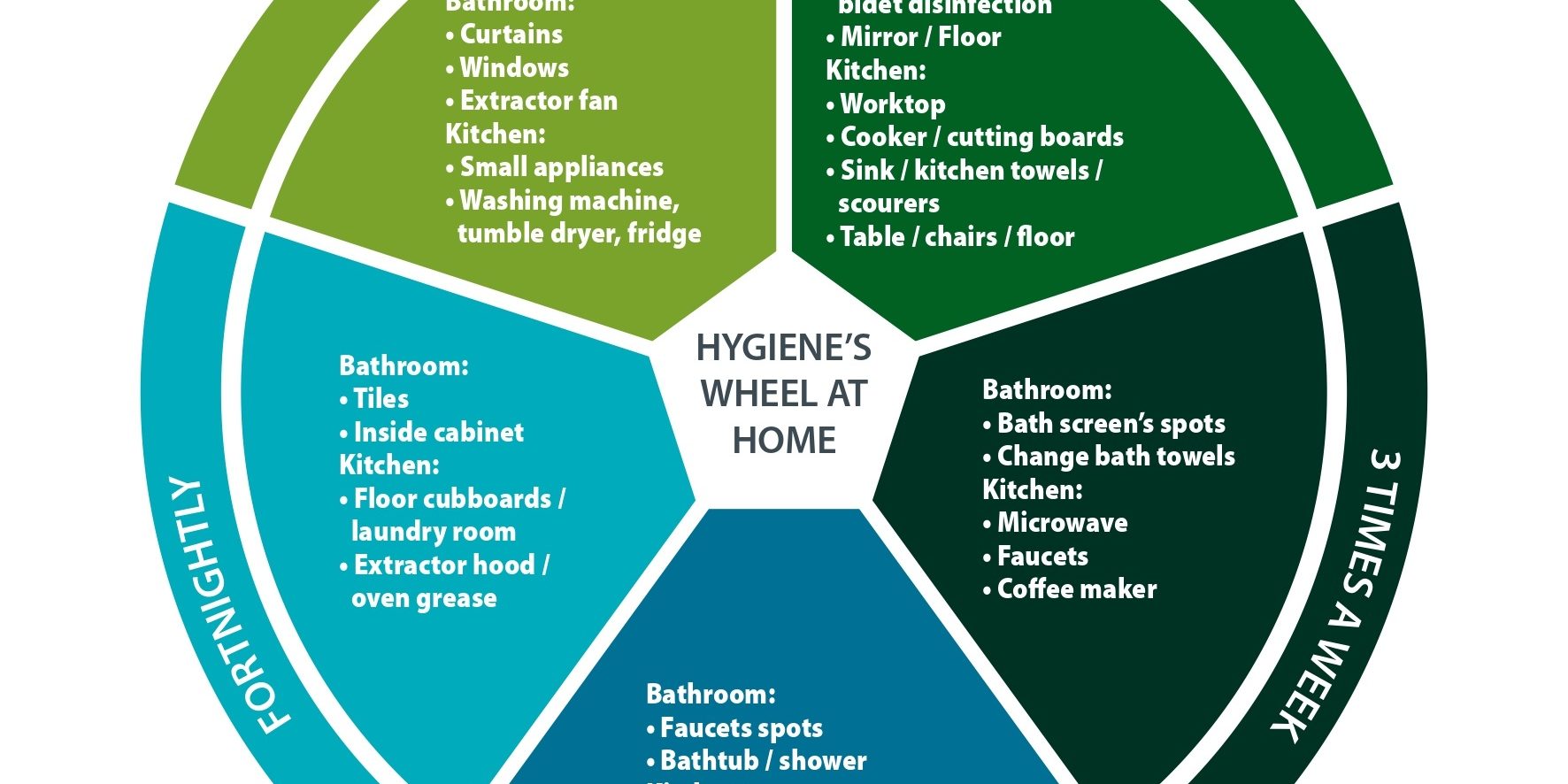The “Hygiene’s wheel at home” by Instituto Silestone
- The extension and duration of Covid-19 has made it necessary to reinforce hygiene guidelines at home as an essential measure to be protected against the virus. The Silestone Institute proposes hygiene guidelines to avoid the formation of sources of infection in the home that could put people’s health at risk. To this end, it presents the Home Hygiene Wheel, which offers some tips for sanitizing the home.
Barcelona, January 26, 2022 – The term “hygiene” is closely linked to the concepts of “health” and “cleanliness”, as it is considered a fundamental element in people’s quality of life and disease prevention.
Kitchen hygiene has traditionally been considered as a set of actions related to food care, good working practices and the cleanliness of people, surfaces and utensils. Likewise, the bathroom, the center of hygiene par excellence both at home and in public spaces, is the place intended to safeguard health through cleaning and disinfection. That is why it is so important to ensure compliance with proper hygiene guidelines in the home in order to avoid the formation of sources of infection that put people’s health at risk.
The Silestone Institute proposes some simple hygiene and cleaning guidelines to achieve complete disinfection. To this end, it proposes the “Wheel of Hygiene in the Home”, a didactic and illustrative diagram to have under control a total sanitation of the home. Thus, the periodicity is distinguished according to the areas that require more repeated and constant cleaning processes, as well as those that must be sanitized more sporadically to keep them in optimal conditions. Therefore, it is detailed which areas require daily, three times a week, weekly, fortnightly or monthly hygiene.
Daily
Daily disinfection is a must for the most contaminated places including kitchen sponges and cloths, the sink and the drain. The chopping board -wooden or plastic- requires special attention, especially after cutting raw meat, poultry or fish and before cutting vegetables that will be eaten raw.
To save time…
Clean the kitchen sink, place the cleaned sponges, cloths and boards inside the sink and cover with a solution of one cup of concentrated bleach in 5 liters of water. Let it act for 5 minutes and then rinse well.
Three times a week
Some areas of the kitchen and bathroom require cleaning and disinfecting several times throughout the week.
Countertops, tables and kitchen utensils/appliances should be disinfected at least three times a week, in addition to wiping them whenever there are any spills on them. Kitchen and bathroom floors, faucet faucets and the toilet flush button are in this group.
Weekly
In the bathroom, the toilet needs to be thoroughly cleaned and disinfected at least once a week, as well as bathroom shelves, sinks, tubs, showers and drains.
Recommendation:
Use concentrated bleach, slightly diluted and let it act for 5 minutes for a degreasing effect. This is also a good way to clean and disinfect in one step.
Sources and sources of bacterial contamination
The truth is that bacteria can be found everywhere. They can be in the air, in the soil, on animals, in water and even on our skin, clothes or saliva. The places where bacteria are commonly found are called sources of contamination.
It is important to know which are the sources of contamination where bacteria are commonly found in order to more efficiently protect the hygienic safety of our home.
The most common sources of contamination
People
People normally carry bacteria on their bodies. These can be in the mouth, nose, intestine, hands and skin. They are most often found on dirty hands, saliva and wounds.
Waste
Waste containers are a very important source of contamination because they are left for several hours at room temperature. This favors the development of bacteria and attracts insects and rodents. Flies, cockroaches or even air currents can cause the waste to reach the food being prepared and contaminate it.
Raw foods
Raw food is usually contaminated by bacteria and parasites. Special care should be taken with red and white meats, fish and seafood, eggs and fresh milk.
Water
A common form of food contamination is from water. This occurs especially where vegetables and fruits are irrigated with sewage or from rivers contaminated with feces or chemicals.
Pests
Pests carry germs and dirt. They are always where there is food. They live in sewers, drains, decomposed matter, and feces.
Domestic animals
The hair and feathers of domestic animals contain a large number of bacteria, some of which are pathogenic.
Soil
Soil is such a nutrient-rich reservoir that many microorganisms and parasites develop easily in it.
Air
Air itself is a hostile medium for microorganisms. But it can become an excellent dispersal and transport medium for them, especially through currents.
